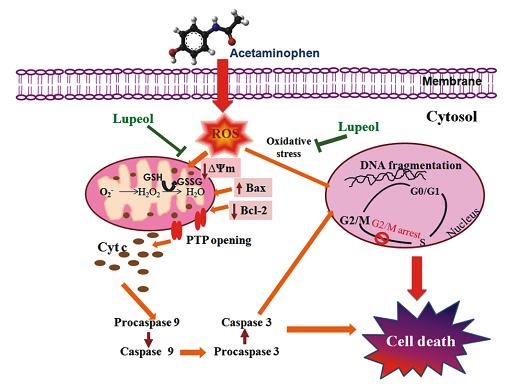2. Lupeol prevents acetaminophen-induced hepatotoxicity by altering the Bax/Bcl-2 and oxidative stress-mediated mitochondrial sig-naling cascade both in vitro and in vivo |
Lupeol, a triterpene, possesses numerous pharmacological activities, including anti-malarial, antiarthritic and anti-carcinogenic properties. It was observed that acetaminophen exposure significantly (P<0.05) reduced cell viability, disturbed Bcl-2 family pro/anti-apoptotic protein balance, increased ROS production and altered redox homeostasis. It also induced mitochondria-mediated injury by significant mitochondrial depolarization, caspase-9/3 activation and subsequent DNA fragmentation in primary rat hepatocytes which was prevented when cells were treated with lupeol. Kumari & Kakkar, Food Chem Toxicol.; 2012; 50; 1781-1789. Further, in vivo studies were conducted to explore the hepatoprotective potential of lupeol against acetaminophen (AAP)-induced hepatotoxicity in Wistar rats. Rats were given a prophylactic treatment of lupeol (150 mg/kg body weight, p.o., for 30 consecutive days) with a co-administration of AAP (1 g/kg body weight). The modulatory effects of lupeol on AAP-induced hepatotoxicity were investigated by assaying oxidative stress biomarkers, serum liver toxicity markers, pro/anti apoptotic proteins, DNA fragmentation and by the histopathological examina-tion of the liver. Lupeol significantly prevented hepatic damage as evident from the histopathological studies and significant decline in serum trans-aminases. The alterations in cellular redox status (p<0.01) and antioxidant enzyme activities together with the enhanced lipid peroxidation and protein carbonyl levels were also observed in the AAP-treated rats. In addition, significant ROS generation and mitochon-drial depolarization were observed in this group. Co-administration of lupeol significantly decreased the level of serum transaminases, MDA and protein carbonyl content. It also prevented ROS generation and mitochondrial depolarization. Furthermore, lupeol enhanced the mitochondrial antioxidant and redox status and inhibited DNA damage and cell death by preventing the downregulation of Bcl-2, upregulation of Bax, release of cytochrome c and the activation of caspase 9/3. The conclusion of this study is that lupeol when co-administered with AAP effectively reduces oxidative stress and prevents AAP-induced hepato-toxicity by inhibiting critical control points of apoptosis. Kumari and Kakkar; Life Sciences; 2012; 90; 561-570
 A schematic diagram showing the protective effect of lupeol in acetaminophen-induced toxicity. AAP causes disturbance in the oxidant/antioxidant balance in the cellular system and results in the permeability transition of the mitochondrial membrane. This further alters the translocation of the mitochondrial death signaling pro/anti-apoptotic proteins, such as Bax, Bcl-2 and cytochrome c, resulting in the activation of the caspase cascade and DNA damage, culminating in cell death. Co-administration of lupeol was found to maintain the oxidant/ antioxidant balance and alter the changes in the mitochondria-mediated apoptotic signaling cascade resulting in the prevention of cell death. |